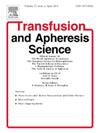Impact of hyperbaric oxygen on post-UCB transplant blood transfusion and growth factor support
IF 1.2
4区 医学
Q4 HEMATOLOGY
引用次数: 0
Abstract
Objectives
This study seeks to evaluate time to packed red blood cell (PRBC) and platelet independence and growth factor use for the HBO study population in comparison to historic UCB transplant data from the same institution.
Background
Umbilical cord blood (UCB) transplantation is limited by low stem/progenitor cell numbers and impaired homing, causing delayed engraftment and higher rates of engraftment failure, which increase post-transplant transfusion needs. Hyperbaric oxygen (HBO) therapy has shown to improve engraftment and blood count recovery in animal models and initial human trials.
Methods/materials
Fifteen subjects underwent HBO therapy at the Univrsity of Kansas Cancer Center (KUCC) after reduced intensity conditioning (RIC) or myeloablative conditioning (MAC) regimens in preparation for UCB transplantation. Six hours following HBO therapy, they received single or double UCB units. Patient records were reviewed for post-transplant PRBC and platelet transfusion requirements and for growth factor use. One HBO patient was excluded from this analysis due to graft rejection and autologous recovery. These were compared to standard UCB recipient requirements from previous KUCC patients.
Results
In the first 100 days post-transplant, HBO patients required fewer consecutive days of G-CSF support and achieved PRBC and platelet independence significantly faster than standard group patients. By days 66 and 74, 100 % of HBO patients were PRBC and platelet independent, respectively, compared to 67.4 % and 65.1 % in the standard group by day 100.
Conclusion
HBO-therapy may offer a potential improvement in growth factor support and TTI in adult patients undergoing UCB transplantation.
高压氧对ucb移植后输血和生长因子支持的影响
目的:本研究旨在评估HBO研究人群到达红细胞(PRBC)和血小板独立性的时间以及生长因子的使用,并与同一机构的历史UCB移植数据进行比较。脐带血(UCB)移植受到干细胞/祖细胞数量低和归巢受损的限制,导致移植延迟和更高的移植失败率,这增加了移植后的输血需求。在动物模型和初步人体试验中,高压氧(HBO)治疗已显示出改善植入和血细胞计数恢复的效果。方法/材料:15例患者在堪萨斯大学癌症中心(KUCC)接受了低强度调节(RIC)或骨髓调节(MAC)方案后的HBO治疗,为UCB移植做准备。在HBO治疗6小时后,他们接受单或双UCB治疗。回顾了移植后红细胞和血小板输血需求以及生长因子使用的患者记录。1例HBO患者因移植物排斥反应和自身恢复被排除在本分析之外。将这些与以前的KUCC患者的标准UCB受体要求进行比较。结果在移植后100天内,HBO患者需要G-CSF支持的连续天数少于标准组患者,且实现PRBC和血小板独立的速度明显快于标准组患者。到第66天和第74天,100 %的HBO患者分别独立于PRBC和血小板,而标准组在第100天分别为67.4% %和65.1% %。结论hbo治疗可改善成人UCB移植患者的生长因子支持和TTI。
本文章由计算机程序翻译,如有差异,请以英文原文为准。
求助全文
约1分钟内获得全文
求助全文
来源期刊
CiteScore
3.60
自引率
5.30%
发文量
181
审稿时长
42 days
期刊介绍:
Transfusion and Apheresis Science brings comprehensive and up-to-date information to physicians and health care professionals involved in the rapidly changing fields of transfusion medicine, hemostasis and apheresis. The journal presents original articles relating to scientific and clinical studies in the areas of immunohematology, transfusion practice, bleeding and thrombotic disorders and both therapeutic and donor apheresis including hematopoietic stem cells. Topics covered include the collection and processing of blood, compatibility testing and guidelines for the use of blood products, as well as screening for and transmission of blood-borne diseases. All areas of apheresis - therapeutic and collection - are also addressed. We would like to specifically encourage allied health professionals in this area to submit manuscripts that relate to improved patient and donor care, technical aspects and educational issues.
Transfusion and Apheresis Science features a "Theme" section which includes, in each issue, a group of papers designed to review a specific topic of current importance in transfusion and hemostasis for the discussion of topical issues specific to apheresis and focuses on the operators'' viewpoint. Another section is "What''s Happening" which provides informal reporting of activities in the field. In addition, brief case reports and Letters to the Editor, as well as reviews of meetings and events of general interest, and a listing of recent patents make the journal a complete source of information for practitioners of transfusion, hemostasis and apheresis science. Immediate dissemination of important information is ensured by the commitment of Transfusion and Apheresis Science to rapid publication of both symposia and submitted papers.

 求助内容:
求助内容: 应助结果提醒方式:
应助结果提醒方式:


